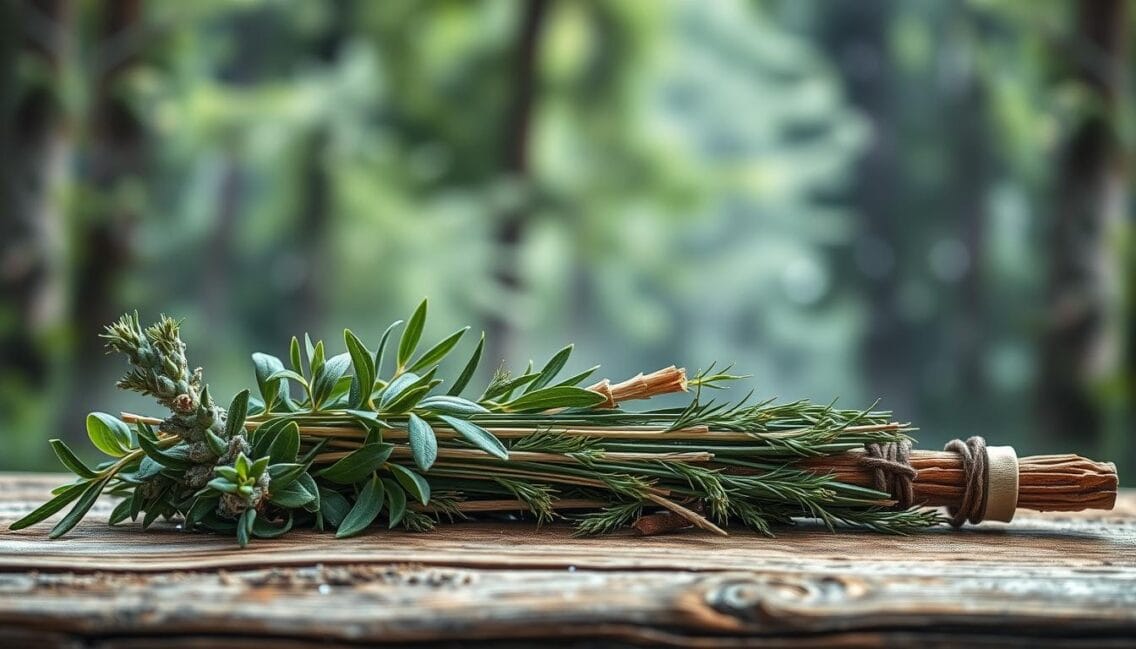Sacred Herbs: Native American Practices to Banish Evil

As the sun sets, the air changes. The smell of sage and cedar fills the room, starting an old ritual. This is smudging, a Native American tradition to clean the spirit and keep away bad vibes. I’ve learned how these sacred herbs can deeply affect our health.
Three main herbs are used: sage, cedar, and sweetgrass. Sage chases away evil spirits, while cedar purifies. Studies show their smoke can kill 94% of harmful bacteria for up to 24 hours. Smudging is key in ceremonies, helping people focus and feel grounded.
The Power of Smoke: Ancient Purification Rituals
Smoke has been seen as a powerful tool for purification across many cultures and spiritual practices. The ritual of smudging is a key example. Indigenous peoples burn specific herbs to cleanse and purify spaces, people, and objects. This ancient practice is deeply rooted in history and is still important in many Native American and First Nations communities.
Historical Significance of Smudging Ceremonies
Smudging ceremonies have been a big part of Native American spiritual practices for centuries. These rituals use sacred herbs like sage, cedar, and sweetgrass. They aim to bring balance, harmony, and a connection to the divine.
The smoke from these herbs is thought to clear negative energies, help with healing, and aid in spiritual growth.
Plants Used in Smoke Cleansing Rituals
The plants used in smoke cleansing rituals are chosen for their special properties and ceremonial importance. Some common herbs include:
- White Sage (Salvia apiana) – Known for its purifying and cleansing properties, white sage is a favorite in smudging rituals.
- Sweetgrass (Hierochloe odorata) – This fragrant grass is often braided and burned to attract positive energy and blessings.
- Cedar (Thuja spp.) – The aromatic smoke of cedar is believed to cleanse and protect against negative energies.
- Mugwort (Artemisia vulgaris) – This herb is used to boost intuition, promote clarity, and prepare the mind for spiritual work.
The careful selection and use of these sacred plants in smoke cleansing rituals show the deep respect and reverence indigenous cultures have for the natural world and its spiritual power.
Indigenous Herbal Traditions of Oklahoma
Oklahoma’s indigenous tribes have a rich history of herbal traditions. This reflects the region’s vibrant cultural heritage. Communities like the Caddo and Muscogee Creek have used native plants and rituals to heal many ailments.
Caddo, Muscogee Creek, and Southeastern Tribes
The Caddo, Muscogee Creek, and other Southeastern tribes are known for their herbal medicines. They use native plants and rituals to heal. They understand the medicinal properties of local plants well.
The Caddo use plants like Cocculus carolinus for its purifying effects. The Muscogee Creek use Asarum canadense (wild ginger) for pain and inflammation.
Plains Indian and Native American Church Practices
The Plains Indians and the Native American Church also have important traditions. The Plains Indians use plants like Echinacea purpurea in ceremonies. The Native American Church uses peyote in ceremonies for spiritual and physical healing.
Oklahoma’s indigenous herbal traditions show a deep connection to nature. They highlight the importance of traditional knowledge in the community’s well-being.
Sacred Herbs: Indigenous Native American Practices to Banish Evil
The indigenous people of North America have always valued sacred herbs and plants. They use these to cleanse spirits and keep evil away. These practices come from the deep wisdom of many tribes, especially in Oklahoma.
Smudging is a key ritual that uses herbs like sage, cedar, and sweetgrass. The smoke from these plants is believed to purify people, objects, and places. It’s thought to remove bad energy and evil spirits. This tradition has been a part of their spiritual lives for centuries.
| Sacred Herb | Traditional Uses |
|---|---|
| Sage | Cleansing, purification, protection |
| Cedar | Healing, purification, protection |
| Sweetgrass | Cleansing, blessing, spiritual connection |
Indigenous communities in Oklahoma also use sacred herbs for healing. These plants help with physical, emotional, and spiritual issues. They help people feel whole and connect with nature and their community.
The use of sacred herbs to banish evil shows the power of traditional healing. It highlights the deep respect for nature. In today’s world, these practices offer a meaningful way to find balance and peace.
Creating Your Own Smudge Sticks
Making your own smudge sticks lets you add personal touches to your spiritual practice. You can use plants that mean a lot to you. This way, you avoid overusing traditional herbs and help protect sacred plants.
Choosing Plants with Personal Significance
Don’t just stick to traditional herbs. Pick plants that speak to your beliefs and experiences. This could be herbs from your garden, wildflowers, or even parts of a special bouquet. The goal is to choose plants that connect with your life and spiritual path.
- Use lavender for peace, rosemary for protection, or roses for love and beauty.
- Find inspiration in nature. Use leaves, flowers, or pine needles that hold personal meaning.
- Try different plants to make a smudge stick that’s truly yours.
Step-by-Step Guide to Making Smudge Sticks
Making your own smudge sticks is easy and lets you customize the experience. Here’s how to make a smudge stick that’s special to you:
- Pick the herbs, flowers, and natural materials you want to use.
- Put the plants together in a tight bundle. Use natural thread to tie it up.
- Hang the bundle upside down in a dry, well-ventilated spot. Let it dry completely.
- When it’s dry, your smudge stick is ready for use in rituals.
By making your own smudge sticks, you ensure they’re fresh, organic, and spiritually aligned. This makes your rituals more meaningful and intentional.
Cleansing Rituals with Smoke
Smoke has been a key tool for spiritual cleansing across many cultures. Native American communities use smoke rituals to fight evil spirits and bring health. These rituals, called “smudging,” use herbs to create purifying smoke.
Purifying Yourself, Others, and Spaces
Smudging can cleanse you, others, and places. It involves lighting herbs and moving the smoke over the area. This smoke is thought to remove bad energy, bringing renewal and clarity.
Smudging Objects and Projects
Smoke can also purify objects and projects. It’s great for new art, tools, or workspaces. The smoke adds positive energy and focus to these items.
Choosing herbs for smudging is personal. Each plant has its own cleansing power. Common ones include white sage, mugwort, sweetgrass, and cedar. Picking herbs that match your needs makes the ritual more meaningful.
The goal of smudging is important, not just the herbs. Setting clear intentions and respecting the ritual makes it powerful. It cleanses and uplifts you and your surroundings.
Conclusion
Using herbs and indigenous Native American practices can deeply connect you with nature. These smoke cleansing and smudging rituals help purify you and your space. They are a strong way to spiritual cleansing.
These ancient practices use sacred herbs to bring balance and harmony. You can make your own smudge sticks or join smoke cleansing ceremonies. These rituals help banish evil and welcome good energy.
Keep exploring these indigenous Native American practices with respect and reverence. They come from a rich cultural heritage. By adding these sacred herb practices to your life, you’ll feel better, connect more deeply, and appreciate nature’s wisdom.
FAQ
What are the sacred herbs and indigenous Native American practices used to banish evil and promote spiritual cleansing?
The article talks about sacred herbs like sage, cedar, and sweetgrass. These are burned in smudging ceremonies to cleanse and purify. These practices come from Native American tribes in Oklahoma, such as the Caddo, Muscogee Creek, and Plains Indians.
What is the historical significance of smudging ceremonies?
Smudging ceremonies have a long history in many cultures. They use sacred herbs to purify. The article looks at the cultural importance and traditional uses of herbs like sage, cedar, and sweetgrass in these rituals.
What are the specific plants used in smoke cleansing rituals?
The article talks about plants like white sage, mugwort, and sweetgrass in smoke cleansing rituals. It also stresses the importance of choosing plants that hold personal significance, not just traditional ones.
What are the indigenous herbal traditions of Oklahoma tribes like the Caddo, Muscogee Creek, and Plains Indians?
The article explores the herbal traditions of these tribes. They use native plants, emetics, and prayer to treat illnesses and spiritual maladies. It also looks at the healing practices of the Native American Church, which includes peyote.
How can I create my own personalized smudge sticks?
The article gives a step-by-step guide to making your own smudge sticks. It suggests using herbs that mean something to you, not just traditional ones like white sage.
How can I use smoke for cleansing and purification rituals?
The article shows how to use smudge sticks for cleansing and purification. It explains how to use smoke for yourself, others, and spaces. It also talks about the importance of intention and the personal significance of the herbs used.



